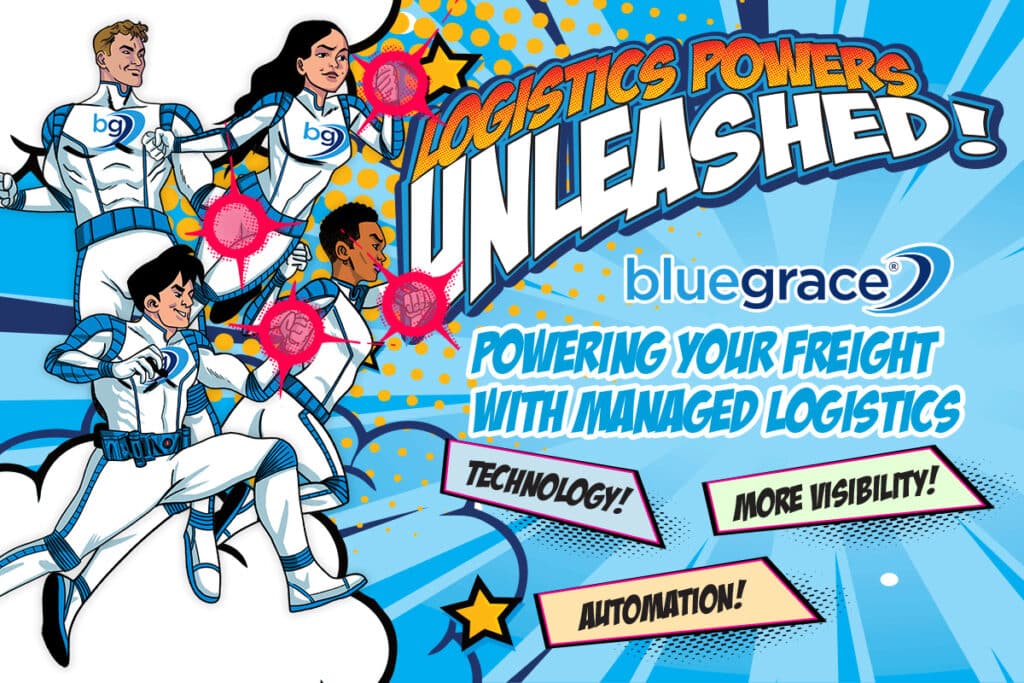
Tampa, Fla.- based non-asset-based 3PL BlueGrace Logistics recently announced that Adam Blankenship, its Chief Commercial Officer, was named as a member of the Digital LTL Council, and will focus on helping to facilitate collaboration and standardization for less-than-truckload (LTL) stakeholders.
Logistics Management
Jeff Berman, Group News Editor
Sep 8, 2021
Tampa, Fla.- based non-asset-based 3PL BlueGrace Logistics recently announced that Adam Blankenship, its Chief Commercial Officer, was named as a member of the Digital LTL Council, and will focus on helping to facilitate collaboration and standardization for less-than-truckload (LTL) stakeholders.
Established in November 2020, the Digital LTL Council’s membership is made up of more than 20 industry stakeholders, including carriers, logistics service providers, shippers and technology providers, focused on developing a set of uniform standards—including electronic bill of lading (EBL), shipment visibility and tracking, and freight exception handling— supporting the scalable automation and digitalization of LTL shipments. What’s more, the organization’s leadership observed that the LTL market is seeing changes occurring at a swift rate, with embargos now more commonplace for both short-haul and last-mile delivery operations.
“On behalf of the Digital LTL council members I welcome Adam and BlueGrace Logistics to the organization,” said SMC³ Chief Commercial Officer Brian Thompson in a statement. “Adam’s leadership and industry experience includes years of leading-edge technology adoption at BlueGrace Logistics, and will contribute to delivering the council’s mission of developing the first-ever set of scalable, uniform standards around digital LTL automation.”
Logistics Management Group News Editor Jeff Berman recently spoke with BlueGrace’s Blankenship about the Digital LTL Council and how he is focused on helping the organization achieve its objectives. Their conversation follows below.
LM: What are some of the main core automation and digitization practices you see in the future for LTL freight?
Blankenship: If you think about over the last ten-to-20 years within the LTL community, there has been a very fragmented approach, in terms of how individual carrier has attacked many challenges and problems.
LM: In what ways?
Blankenship: It could be things like communications with customers, documentation requirements, paperwork requirements, all of those things regarding how we communicate between, or among, the shipper, the consignee, the provider, intermediary (in case it is a 3PL engagement, too). It typically tends to be a misaligned, fragmented, scattered approach…so I think a major objective of the council is to start looking at commonality and common ground as to how do we get rid of as many as these non-value or non-value-creating processes that can simply be improved upon by simply adding basic rules of governance and standard things that we can all agree on. It could have the approach of: “Here is how we are going to attack these problems and make web service connectivity work more consistently for one another and not necessarily change the basis of how we compete, but more along the lines of “why don’t we try to create a way to make this stuff work better so that it enables things like ML/AI and at the very least just minimize some of the human interventions to reduce some of the mistakes and errors we see made that are ripe throughout this space on the LTL front?
LM: That has been a common refrain over the years, correct?
Blankenship: Unfortunately, that has been a big part of the legacy over the years, in that there has been a lot of manual human touch on paperwork, a lot of manual paper shuffling, and that is just fraught with problems. This is an earnest effort to attack that and ultimately in the process of digitizing so much of that you are going to create [digitization] and you are going to create a better environment and a more error-free environment….also the process of creating a more streamlined, harmonious set of data and digital practices that unlocks this stream of data and leads to way cooler things, including how carriers and the LTL providers themselves are engaged with their customers from a business intelligence or a predictive analytics standpoint, certainly for folks like us as BlueGrace and how we want to drive our value proposition for customers. It does center around performance of the tasks, collecting and using the information in thoughtful and really creative ways that to drive better business solutions for customers.
At the end of the day, the people that really benefit are our customers seeing a higher quality delivery of product in terms of thoughtfulness and supply chain solutions with lower error rate and improved billing experience and key efficiency gains for carriers, LTL providers, and 3PLs like us and also further building customer relationships
LM: What are some of the main ways in which the Digital LTL Council is approaching carrier (and broker)/shipper collaboration, at a time when rates are high and capacity can be tough to come by?
Blankenship: The simplest answer is that the entire broader supply chain community—3PLs, shippers, and providers [involved in LTL freight]—are all faced with the same reality that there is more freight than there is capacity to handle all of the freight. That has been true for the last 12 months, and there is not a lot of compelling data to suggest that it is not going to be true for the next 12 months. I think what we would expect to see is a pretty challenging freight environment for the foreseeable future—some of that is Covid related and some is not, there are also issues with ocean containers and some other stuff is more nuanced than that.
What we have seen is how the way people buy has changed, as well as the way people ship, too. Inefficiencies and some of the modal realities of unpredictable ocean freight has really changed. The way we used to do it was: “we are swamped so let’s go buy trucks, put more drivers in those trucks and make more hires, raise rates, make money at it—let’s just go get it done.”
The reality is, even if I raise rates right now, the “let’s just go get it done thing” is not a guarantee, because the labor pool is somewhat finite, at least in the short term right now. We are looking for opportunities to create efficiency and process, and scale up unintegrated systems over the years. They are really going to struggle to meet the demands that are out there in the supply chain today, and they are going to miss business opportunities at a moment when that is unfortunate because it is an opportunity for the LTL community, in general, which has largely been undercapitalized, so it has had a hard time making a lot of money over the last 20 years except for some of the very best in this space.
LM: What are the next steps then?
Blankenship: This is a moment where the LTL community can get a lot healthier and recapitalize their fleets and really set themselves up to have the right systems tech, physical equipment and physical asset infrastructure. These are the moments in the market they need in order to make money so they can make those large capital improvement budgets and those large capital expenditures and set themselves up to handle the next 20 years of their supply chain…but they cannot do it, because they cannot hire the people needed to help run the business. It is going to be challenging.
I do feel like the Digital LTL Council is a lot of people with common interests focused on how to be more efficient at doing some basic blocking and tackling within the space so that we can redeploy some of our time, energy, talent, money, and people into things that create more value and widen our capacity to serve more customers and do it on a more error-free and exception-free basis. Whether you are a 3PL or an LTL carrier or a shipper or TL provider, there is a lot of commonalities in the sense that we are all faced with the same challenges with more demand than supply, and there is only so much you can do in writing a bigger check and raising wages if you don’t fix some of these systemic, ingrained processes that have been far too fragmented and broken for decades in some cases…you are only going to have a limited opportunity to widen how much capacity you have
LM: What is the current status of the council’s development of standards for EBL, shipment visibility and tracking, and freight exception handling?
Blankenship: The core focuses are on picking off major systemic problems that tend to be fraught with errors, exception management, and re-work, and, as a byproduct of that, lost time, energy, and customer dissatisfaction. Many of these things are basically screaming at basic process re-engineering, process improvement, and outlining standards for these things.
Clearly, we want to understand things like how we communicate with each other. Web services integration, client to client and customer to customer is massively important, and it is facilitated so much easier when we are all speaking the exact same language and same dialect. That starts with a document, where a set of governing principles and rules and how we are going to do that, becomes so much easier to come in and plug in and create that non-manual process and, ultimately, if we can collect data, transfer data and share it back and forth through EBL standardization, our web service connection, and our API or EDI connections, then some of the other stuff begins to take care of itself a bit more. Things like shipping and tracking visibility and others are enabled way more effectively just simply because we have interconnected platforms. Today, a lot of platforms are not interconnected for even large size client relationships.
Click here to read the entire article at Logistics Management




